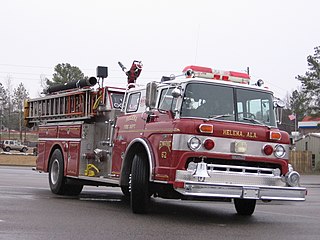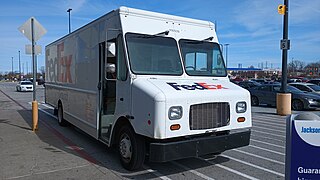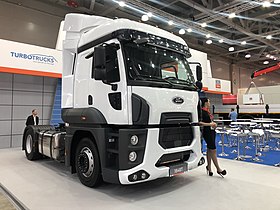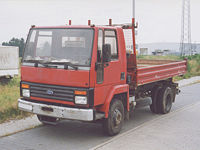Iveco S.p.A., an acronym for Industrial Vehicles Corporation, is an Italian multinational transport vehicle manufacturing company with headquarters in Turin, Italy. It designs and builds light, medium, and heavy commercial vehicles. The name IVECO first appeared in 1975 after a merger of Italian, French, and German brands. Its production plants are in Europe, China, Russia, Australia and Latin America and it has about 5,000 sales and service outlets in over 160 countries. The worldwide output of the company amounts to around 150,000 commercial vehicles with a turnover of about €10 billion.

The Ford Transit is a family of light commercial vehicles manufactured by the Ford Motor Company since 1965, primarily as a cargo van, but also available in other configurations including a large passenger van, cutaway van chassis, and a pickup truck. The vehicle is also known as the Ford T-Series, a nomenclature shared with Ford's other light commercial vehicles, the Ford F-Series trucks, and the Ford E-Series chassis. As of 2015, 8 million Transit vans have been sold, making it the third best-selling van of all time and has been produced across four basic platform generations, with various "facelift" versions of each.
Freightliner Trucks is an American semi truck manufacturer. Founded in 1929 as the truck-manufacturing division of Consolidated Freightways, the company was established in 1942 as Freightliner Corporation. Owned by Daimler AG from 1981 to 2021, Freightliner is now a part of Daimler Truck subsidiary Daimler Truck North America.

Sterling Trucks Corporation was an American truck manufacturer. Founded in 1998, Sterling was created following the 1997 acquisition of the heavy-truck product lines of Ford Motor Company by Freightliner. Taking its nameplate from a long-defunct truck manufacturer, Sterling was slotted between Freightliner and Western Star within the Daimler product range.

The Mercedes-Benz Sprinter is a light commercial vehicle (van) built by Mercedes-Benz Group AG of Stuttgart, Germany as a large van, chassis cab, minibus, and pickup truck. In the past, the Sprinter had been sold under the Mercedes-Benz, Dodge, and Freightliner nameplates. In the U.S., it was built from complete knock down (CKD) kits by Freightliner. Re-badged and re-engined Sprinters were also sold by Volkswagen Commercial Vehicles as the Volkswagen LT and the Volkswagen Crafter. They are now primarily marketed by Mercedes-Benz.
Ford Otomotiv Sanayi A.Ş., doing business as Ford Otosan, is an automotive manufacturing company based in Turkey that is equally owned by Ford Motor Company and Koç Holding. The company was established in its current form in 1977, with original relations dating back to 1928. It currently operates in six locations: Gölcük and Yeniköy plants in Kocaeli, İnönü plant in Eskişehir, Craiova plant in Romania, Sancaktepe R&D Center and spare parts warehouse in Istanbul The company employs more than 20,000 people and had a production capacity of over 700,000 vehicles, 400,000 engines, and 140,000 powertrains by 2022.

The Ford C series is a range of trucks that was produced by Ford between 1957 and 1990. The first cab over engine (COE) truck produced with a tilting cab by Ford, the C series replaced the C-series COE variant of the F-Series, produced since 1948. Produced as both a straight/rigid truck and a tractor, many versions of the C series were produced, ranging from Class 5 to Class 8 GVWRs. The C-series was also used as a basis for fire apparatus production.

The Iveco Stralis is a heavy-duty truck produced by the Italian manufacturer Iveco between 2002-2019. The Stralis replaced the EuroStar and EuroTech models; it covers the range above the Eurocargo, between 19 and 44 tonnes. The fire version of the Stralis released with the German based Iveco Magirus.

The Ford L-series is a range of commercial trucks that were assembled and marketed by Ford between 1970 and 1998. They are also known as Ford Louisville or, for the 1990s aerodynamic models, Ford Aeromax. The first dedicated Class 8 truck produced by the company, although Ford had been producing "Heavy Duty" trucks since 1948 and their "Super Duty" lineup since 1958. The L-Series was the successor of the F-900/F-1000 Super Duty and the Ford N-Series. The line encompassed a wide range of models in GVWR Classes 6 through 8, as either straight trucks or as semi-tractors, with vehicles developed for medium-duty, on-highway, severe-service, and vocational applications.

A multi-stop truck is a type of commercial vehicle designed to make multiple deliveries or stops, with easy access to the transported cargo held in the rear. They are usually vans or trucks designed to be used as fleet vehicles by businesses within local areas. They typically use commercial truck chassis with a generally larger, taller body and sometimes also a longer or shorter wheelbase. Though they have traditionally been powered by internal combustion engines, into the 21st century many multi-stop trucks have begun shifting to electric truck platforms.
Astra Veicoli Industriali S.p.A. is an Italian company that produces trucks, heavy transport vehicles and military vehicles. Astra was privately founded in 1946 in Cagliari, and since 1986 has been part of Iveco. In 1951 Astra moved to Piacenza. From 1946 to 1986 Astra was owned by the Bertuzzi family of Piacenza. ASTRA is an Iveco Group brand.

The Ford P100 is a car-based pickup truck that was built by Ford from 1971 to 1995, initially in South Africa, and later Portugal. It was based on medium-sized Ford passenger cars, originally the Cortina/Taunus and from 1988 the Ford Sierra. Initially marketed as the Ford Cortina Pickup, the P100 name was adopted in 1982. The P-100 name had previously been used on a small North American panel van in the 1960s.

The Club of Four was an alliance of four European truck manufacturers: Saviem, Volvo, DAF, and Magirus-Deutz.

Ecotorq is a heavy duty diesel engine family primarily used in Ford Cargo heavy duty trucks, designed and built by Ford Otosan. Ecotorq is the first diesel engine which is completely built with CAD/CAM technologies in Turkey. Ecotorq family is produced in Ford Otosan's truck and engine transmission plant located in İnönü, and JMC Xiaolan engine plant in Nanchang, China under license of Ford Otosan.

The Freightliner Business Class M2 is a model range of medium-duty trucks produced by Freightliner since the 2003 model year. The first generation of the Business Class developed entirely by Freightliner, the M2 replaced the FL-Series introduced in 1991. Serving as a Class 5-Class 8 product range, the M2 competes primarily against the International MV and the Ford F-650/F-750 Super Duty.

The Ford LCF is a medium-duty cab-over truck that was marketed by Ford Motor Company from 2006 to 2009. The first cab-over (COE) vehicle sold by Ford since the company sold the rights to the Ford Cargo design to Freightliner in 1996, the LCF was developed as a Class 4/5 truck, competing in a market segment dominated by the Isuzu NPR. Sold in various wheelbases, the model line was developed for various configurations, including dump trucks, fire trucks, tow trucks, box trucks, crane/bucket trucks, flat beds and stake bodies.

The Iveco Zeta is a light to medium-duty truck model produced by the Italian manufacturer Iveco. Appearing in 1976 and entering production in 1977, its cab was developed with the aid of Fiat's wind tunnel in Orbassano. The Zeta series continued the lineage begun with the 1959 introduction of the OM Lupetto. The Lupetto, as well as the Leoncino, the Daino, and the Tigrotto, were all replaced by the OM X-series in 1972, which then formed the basis for the Zeta range. The Zeta itself was replaced by the all-new Iveco Eurocargo in 1991.

The Iveco EuroCargo is a range of medium-duty trucks produced by the Italian manufacturer Iveco since 1991. The EuroCargo occupies a place between the light Daily and the heavy Stralis in Iveco's lineup. The EuroCargo replaced the Zeta model produced in the 1970s.

Thames was a commercial vehicle brand produced by Ford of Britain.




















